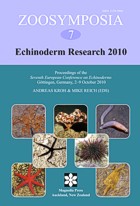Abstract
In general, holdfasts (including distalmost stalk plates) of bourgueticrinid crinoids (Comatulidina, Bourgueticrinina) are comparatively rare in Maastrichtian (Upper Cretaceous) strata in the extended type area (northeast Belgium, southeast Netherlands). Here we describe a number of examples of such holdfasts. Two of these are of note in comprising up to two dozen specimens in different size classes, with a predominance of juveniles, in close proximity to larger, ‘fully grown’ individuals. All specimens are of late Maastrichtian age and are found on tests of holasteroid echinoids of the genus Echinocorys Leske. The majority stem from the Lixhe 1 and 3 members (Gulpen Formation) at the former CPL SA quarry (Haccourt, Liège, Belgium), and at a disused quarry between Houtain-Saint-Siméon and Roclenge-sur-Geer (Liège). A single example is from the underlying Vijlen Member (Gulpen Formation) at the ENCI-Heidelberg Cement Group quarry (Maastricht). The clustering of juvenile and ‘fully grown’ holdfasts on two tests suggests at least three different spat falls. Settlement of crinoid larvae close to the tallest point of the test would have been conducive to further development, but the close proximity may also have had a detrimental effect on feeding, by interference from neighbours. Current action or probing by a predator or scavenger appears to have tumbled the echinoid tests, leading to the premature death of the recently settled crinoids by smothering.

